|
|
 |
|
|
Stoner vs. Kalashnikov: Infantry Weapons in Vietnam
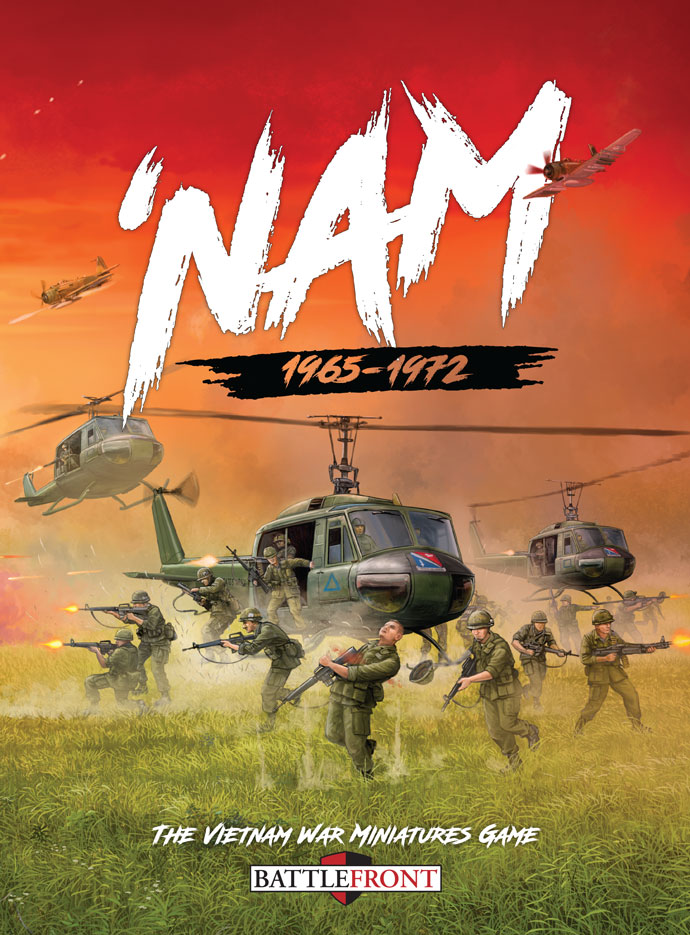 |
Stoner vs. Kalashnikov:
Infantry Weapons in Vietnam
by Phil Yates with additional text by Blake Coster
The Vietnam War was not only a clash between the political ideologies of the communist east and the capitalist west was but also two contrasting styles of warfare. The infantry weapons used in the fire fights across South-East Asia often reflected these ideological differences.
|
The M16
The M16 rifle was the brainchild of Eugene Stoner. It was a revolutionary lightweight rifle (just over half the weight of the M14 rifle it replaced). Firing a 5.56mm round instead of the then standard 7.62mm round, it could fire accurate bursts and the ammunition was light enough for soldiers to carry twice as much.
Unfortunately, the early models suffered severe reliability problems due to design changes made just before it was rushed into service in 1964. The modified M16A1 rifle issued in 1967 resolved many of these problems and the M16 serves on to this day.
Right: American soldiers put their M16A1 rifles to work. |
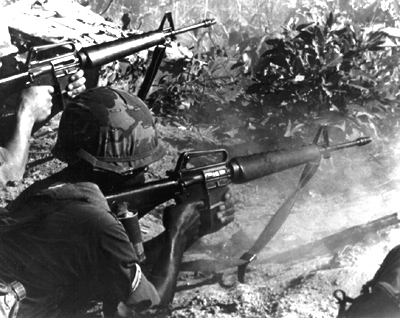 |
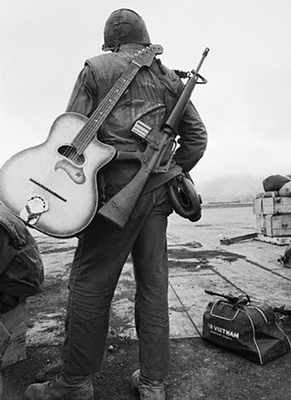 |
The US Army saw the M16 as a standard rifle, and tended to use it that way. That’s not to say that automatic fire didn’t prove very useful for stopping assaults in conjunction with the fire team’s M79 grenade launcher firing flechette ammunition like a giant shotgun.
Mechanised rifle squads added an M60 machine-gun for extra firepower, significantly increasing their hitting power and range.
Left: An American G.I. with his slung M16 and guitar awaits evacuation. |
 |
Left: The original version of the M16 issued to troops in 1964. |
| Right: The revised M16A1 issued during 1967. |
 |
| Below: Field manuals in cartoon form were issued to soldiers on how to maintain the M16 and what to do in case of a stoppage. |
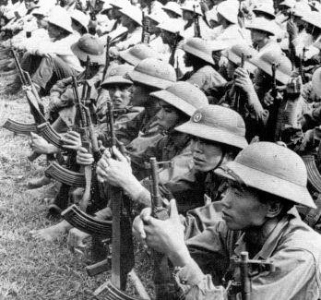 |
The AK-47
Whereas the M16 was initially opposed by the US Army, the AK-47 was developed to meet a Red Army requirement for an assault rifle, an improved submachine-gun capable of engaging the enemy at much longer ranges. Mikhail Kalashnikov’s design was accepted for service in 1947.
Having started designing weapons while recovering from being shot in the Battle of Bryansk in 1941, Kalashnikov designed a weapon that would stand up to the rigouts of the front line. The resulting weapon is renowned for its reliability.
Left: PAVN soldiers armed with the AK-47. |
The AK-47 fires the same round as the SKS carbine, and the People’s Army of Vietnam use the two weapons together in equal quantities. As well as the AK-47 and SKS, the PAVN squads carried a light RPD squad automatic weapon and a B-40 or B-41 RPG rocket launcher giving them serious short-ranged firepower.
Due to the lack of ammunition for training, marksmanship was not always up to scratch. However, plenty of automatic weapons compensated to a degree.
Right: A Vietnamese Guerrilla fighter with his AK-47. |
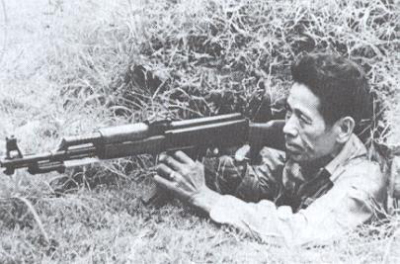 |
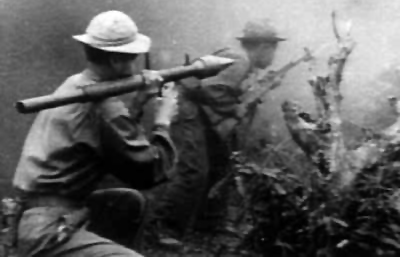 |
The B-40/B-41 RPG
One of the key weapons in a Vietnamese platoon was its three B-40 or B-41 RPG (rocket propelled grenade) rocket launchers. These were Chinese-made copies of the Soviet RPG-2 and RPG-7 rocket launchers, and were used in large numbers. Almost every arms cache unearthed by US forces contained rocket launchers, rockets or both with rifle ammunition.
Left: A PAVN soldier armed with a B-40. |
Although the B-41 started to appear in numbers during 1968, it never completely replaced the B-40. In part this was due to the number of older weapons in service, but also in part it was a matter of choice. While the newer B-41 had much better penetration, making it far more effective against tanks, it sacrificed some performance against other types of target.
The warhead of the older B-40 may not have been as well designed for anti-tank work, but its explosive effect was much greater.
Right: The B-41 in action.
|
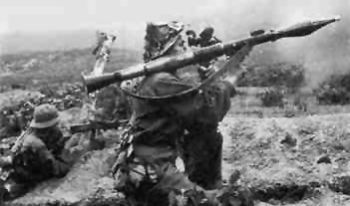 |
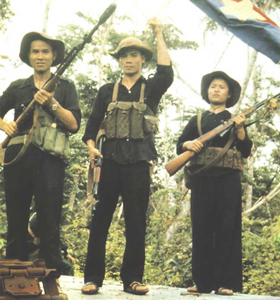 |
The SKS Carbine
Vietnamese forces also made extensive use of the Soviet designed SKS carbine. Receiving supplies from communist China, the Type 56 carbine was a direct copy of the SKS (Samozaryadnyj Karabin sistemy Simonova, 1945) and chambered the same 7.62x39mm round of the AK-47.
Outwardly, the Type 56 resembled a standard bolt-action rifle. However, the weapon cycled via gas operation and was feed by 10-round magazine which was loaded via a deposable stripper clip.
Left: Vietnamese Guerrilla fighters armed with various small arms including a SKS carbine.
|
Fitted with a hinged bayonet that folded under the muzzle when not in use, the rifle had an effective range of 450m; making it an ideal weapon for an ambush.
It was simple to operate and maintain. This was especially important in the harsh environment experienced on the battlefields of Vietnam and in the hands of inexperience soldiers and guerrilla fighters.
Right: A Vietnamese Guerrilla fighter shelters in a tunnel with his SKS carbine. Note the folding bayonet under the barrel. |
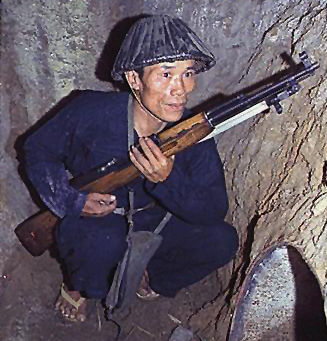 |
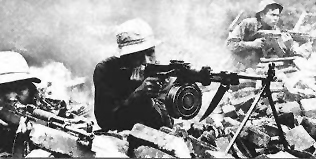 |
The RPD
Another Soviet designed weapon utilised by Vietnamese was the RPD light machine gun. Again, supplied in the form the Chinese copy Type 56, it proved popular with the forces of the NVA due to its weight and its suitability to the style of warfare used by the armed forces of the North.
Left: An RPD offering fire support. |
The weapon was feed by a drum magazine which held a 100-round coiled belt; this meant that it could be operated by a single man unlike the two man crew of the American M60. However, the weapon system was not without its draw backs.
Right: An image showing the belt feed of the RPD. |
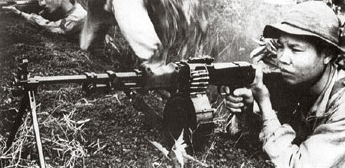 |
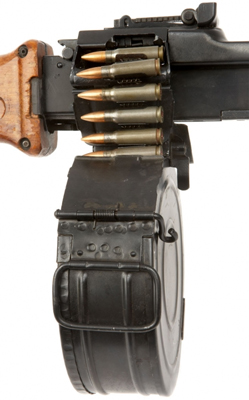 |
One of these was the risk of overheating, causing the weapon to jam. Since the RPD had a fixed barrel, gunners were trained to fire in short burst and keep their rate of fire below 100 rounds per minute. Another drawback was the feed system; the operation of loading a fresh round into the chamber required the mechanism to lift the weight of the belt contained in the drum. This system was liable to jam if the links were even slightly damaged.
Left: A close-up view of the drum magazine and the feed system on the RPD. |
The M60
The M60 evolved as a result for the desire of the US Army to replace the Browning light and heavy machine-guns in favour of a general purpose machine-gun in a similar vein of the German MG42 used during World War Two.
The mechanism of the M60 was gas-operated unlike the recoil system used by the Browning designed machine-guns. This system relied on the gases tapped off to drive a piston which in turn cycled the weapon. However, the weapon lacked a gas regulator (the ability to adjust the amount of gas used to cycle the weapon) and any accumulated dirt or dust would cause the weapon to either jam or run away (continue firing after pressure on the trigger had been released).
Right: An American soldier move through the undergrowth with his M60. |
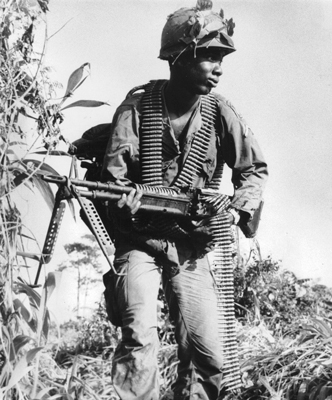 |
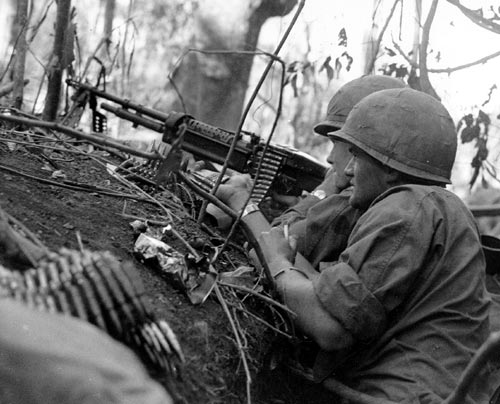 |
If this occurs in the heat of battle, the crew would have to prevent the belt from feeding by forcefully holding it and prevent a new round from being chambered. The weapon also had no accommodation for semi-automatic fire; however a skilled gunner could squeeze off single shots with a quick release of the trigger.
Left: US soldiers defend as position with their M60. |
Other features included a changeable barrel, however the lack of a handle on the barrel meant the barrel itself had to be handled. With the barrel temperatures reach upwards of 500°C, an asbestos mitten was issued to address this problem but was often misplaced and led crew to improvise a replacement in the heat of battle. One of the best futures of the weapon was its chromium-plated barrel; which greatly extend the life of the barrel.
Right: It was important to maintain a plentiful supply of ammunition to feed "The Pig". |
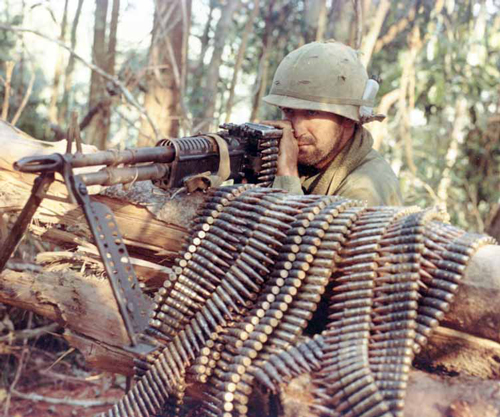 |
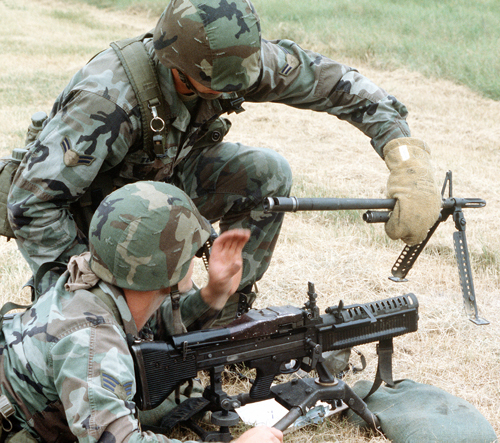 |
The M60 could be fired from a bipod as a light machine-gun or mounted on a tripod for sustained fire as a heavy machine-gun. The M60 saw extensive service throughout the course of the Vietnam War and as a result the design was modified to improve performance in the field as a direct result of the weapons extensive combat use.
Left: Troopers use the asbestos glove to change the barrel of their M60 during an exercise. |
The M72 LAW
Developed to replace the 3.5” M20 Super Bazooka used the Korean War to combat the Soviet supplied tanks such as the T-34/85. The M72 LAW (Light Anti-tank weapon) relied on its shaped charge to penetrate up to 300mm of armour. Designed as a light weight (each weighing 2.36kg) one-shot disposable weapon similar to the Panzerfaust used by German forces in World War Two; this meant that weapon could easily be carried by an infantrymen.
The 66mm rocket was held in an aluminium cylinder housed in two concentric fibre glass tubes. The weapon was armed by removing the covers from each end of the tube and pulling the tubes apart and elongating it into a single tube. The safety handle was then pushed forward and the weapon was ready for firing. The rocket was then fired from the shoulder by pressing the trigger mounted in front of the sight.
Right: A carries a M72 LAW on patrol. |
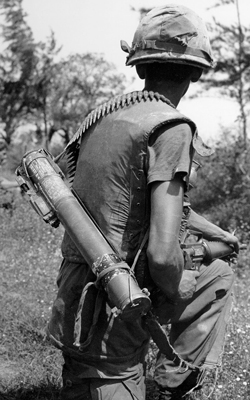 |
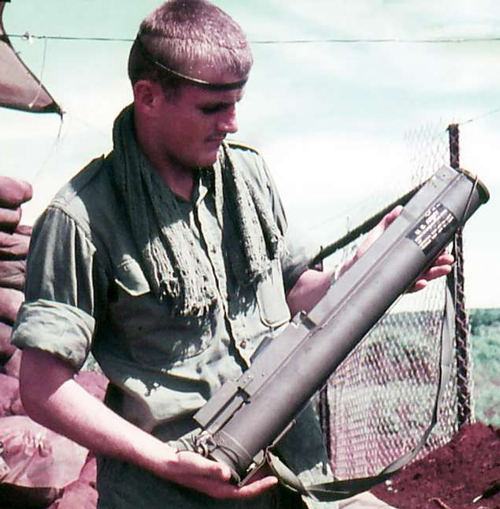 |
However, the weapon was not without its drawbacks. The first being accuracy; this only came after repeated firings, mainly due to the small warhead, short range and rudimentary sighting system of the weapon. This was further hindered by lack of instruction of how exactly to knock-out tanks and bunkers. Secondly, if the M72 was stored for any prolonged period of time, the electronics had a tendency to fail due to corrosion.
When proper training on the use of the weapon was provide, it proved an effective weapon. As shown by the ARVN (Army of Republic of Vietnam) forces in the defence of An Lộc during the Easter offensive in 1972.
Left: A G.I. shows off a M72 LAW. |
The M79
Making its combat debut during the Vietnam War was the M79 grenade launcher or Blooper as it was also known as. This 40mm grenade launcher resembled a giant sawn-off shotgun and was designed as a close support weapon to bridge the gap between the maximum range a grenade could be thrown and the shortest range of any mortars in support i.e. between 50m-300m.
Right: ARVN troops receive training on using the M79 grenade launcher. |
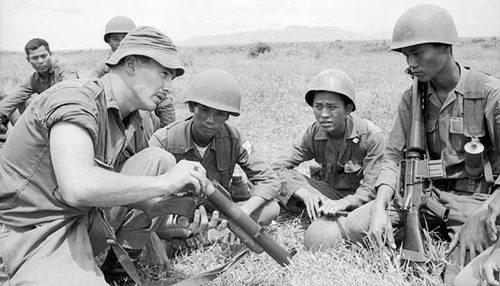 |
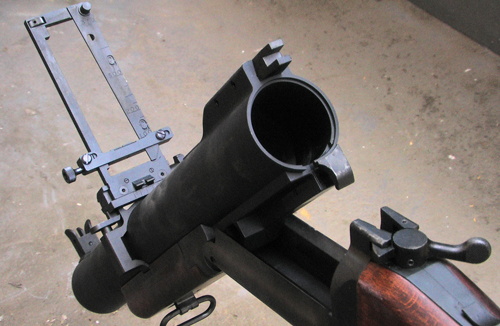 |
The weapon was loaded in a similar fashion as a shotgun, breaking open at the breech in which the 40mm grenade was loaded. Upon firing, the grenade was stabilised in flight by fins and the spin imparted on the spherical grenade by the rifling inside the barrel. The grenade itself had a relatively low muzzle velocity (75m per second) and armed itself after travelling 30m.
Left: A close-up view to the M79 ready for loading and the flip-up leaf sight. |
This meant that the round couldn’t be accidentally detonated by being dropped or struck in anyway. It also meant that the grenade only detonated at a safe distance from the grenadier. A trained grenadier was expected to be able to put a grenade through a window at ranges up to 150m.
The M79 was capable of firing a number of different types of ammunition depending on the situation being faced on the battlefield. These included airburst projectiles, flares, and gas grenades and for close range support buckshot round and a flechette round which held 45 dart-like projectiles.
In order to use the M79 effectively, the gunner had to carry as little extra equipment as possible. This meant only a pistol was usually carried as a secondary armament. The M79 was eventually phased out in the later stage of the Vietnam War in favour of the M203 grenade launch that was fitted to the M16, allowing the grenadier to participate in a fire fight as a regular rifleman until called upon to use the grenade launcher.
Right: A M79 grenade launcher in action.
~ Phil & Blake. |
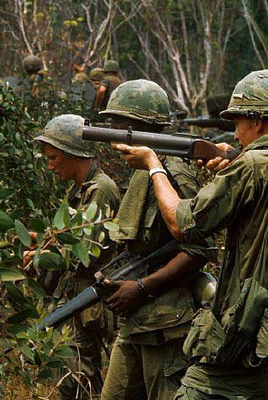 |
Last Updated On Wednesday, July 19, 2023
|
|
|